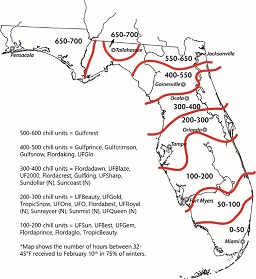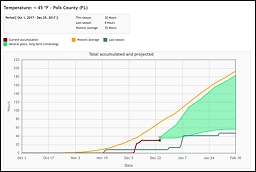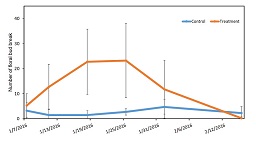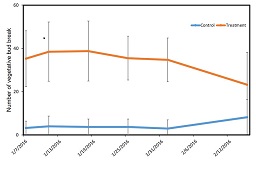Article from
VSCNews, Vegetable and Specialty Crop News
by Tripti Vashisth and Mercy Olmstead
Hydrogen Cyanamide for
Low-Chill Peaches
in Florida

Fig. 1 
Chill-unit accumulation in Florida (below 45 F through Feb. 10) with low-chill peach/nectarine (N) cultivar options.
Interest
in Florida peach production remains steady, with approximately 2,000
acres in the state. Florida peach growers have a number of advantages:
1)
Early flowering and fruit set result in the ability to harvest fruit
earlier in the domestic market window, yielding higher economic returns.
2)
Recent surveys show that consumers prefer local produce, making early
Florida peaches desirable in comparison to peaches imported from Latin
America.
3) Peach breeding programs led by University of Florida and
Texas A&M have resulted in a number of low-chill peach
varieties
which are suitable to be grown in the southeastern United States.
CHILL-UNIT
ACCUMULATION
Peach
trees are deciduous and enter dormancy. This means the trees shed their
leaves during the late fall and early winter. During this dormant
stage, a certain amount of cold weather (measured by accumulation of
chill units) is needed to resume normal growth in the spring.
Low-chill
peach varieties require fewer chill units compared to varieties grown
in more northern states, making them suitable for mild winter regions
of the Southeast. Therefore, selecting the right peach cultivar is very
important. Peach varieties that do not accumulate the required
chill-unit accumulation can result in poor or uneven budbreak, sporadic
flowering, delayed leaf emergence and poor fruit set. Figure 1 shows
the chill accumulation range in Florida and potential peach variety
options for those regions. Fawn.ifas.ufl.edu and Agroclimate.org are
the most common websites to monitor chill-unit accumulation in Florida.

Fig. 2 
Chill-unit accumulation for the current season, last season and the
historic average in Polk County, Florida. In 2016 (shown by turquoise
line), accumulated chill hours were less than 50 for the entire season.
The figure is directly adapted from
https://agroclimate.org/tools/Chill-Hours-Calculator.
There
are several models used to calculate the accumulated chill units. The
most common model, Weinberger (1950), adds the total number of hours
below 45 F during the fall and winter months. The range of time used
for chill-unit accumulation calculation takes into account the time
period from defoliation to first bud swell, which for Florida is
typically Oct. 1 to Feb. 10.
Even with several low-chill
varieties available to Florida growers, mild winter temperatures and
climate variability challenge Florida peach production. In 2016,
Central Florida accumulated less than 50 chill units by the end of
January (Figure 2), which is less than half of the historic average at
any given time. Mild winters interrupt the onset of dormancy and
chill-unit accumulation, causing extended bloom periods, non-uniform
flowering and leaf budbreak. Both extended bloom and non-uniform
budbreak can cause loss of marketable fruit and non-uniform ripening,
creating labor and economic challenges.
In growing areas with
low chill-unit accumulation, hydrogen cyanamide (HCN) has been used to
aid in the process of overcoming chill-unit requirements. Several
reports on grape, blueberry, kiwi, apple and peach indicate that when
inadequate chilling is received during the dormant season, the use of
HCN is effective in releasing dormancy and enhancing uniform budbreak.
HCN works best when a significant amount of chill units have already
accumulated. However, if applied after bud swell, phytotoxicity can
occur, damaging the flower buds.
TRIAL SEES
SUCCESS
In
order to ensure that HCN works well for low-chill peach cultivars under
Florida conditions, we set up a trial at the University of Florida
Plant Science Research and Education Unit in Citra (Marion County) with
the peach cultivar TropicBeauty. We applied HCN at a rate of 1.2
percent active ingredient and monitored the trees for floral and
vegetative growth.
Trees treated with HCN broke bud
approximately one-month earlier than the control, and floral budbreak
was uniform and compressed (Figure 3). The fruit from HCN-treated trees
ripened uniformly and were of marketable quality. The overall yield was
higher from untreated (control) trees as there was a prolonged bloom
with fruit set throughout the spring; however, these fruits were of low
quality and unmarketable. Overall, this trial suggests that HCN can be
successfully used in Florida for uniform budbreak and to compensate for
insufficient chill units.

Fig. 3 
Floral budbreak in hydrogen cyanamide- treated and untreated control
trees over 40 days after hydrogen cyanamide application in TropicBeauty
peach.
GETTING
APPLICATION TIMING RIGHT
When
using HCN as a management tool, it is critical to apply it at the right
time, as some amount of chill units are required for good efficacy.
Late application may result in phytotoxicity and can cause flower and
vegetative bud damage.
Pollen grain color has been initially
suggested as an indicator of when to apply HCN
(aces.edu/dept/peaches/chillcom20jan.html). Therefore, in our trial, we
monitored flower bud pollen grain color. We found pollen grains ranging
in color from translucent white to bright opaque yellow on the tree at
any given time in late December.

Fig. 4 
Vegetative budbreak in hydrogen cyanamide-treated and untreated control
trees over 40 days after hydrogen cyanamide application in TropicBeauty
peach.
The
application was made when the majority of flower buds contained
translucent pollen grains. When pollen grains are translucent and not
opaque, HCN has been successfully applied with positive effects on
budbreak and uniform blooming. However, as the pollen grain color
changes to yellow, the application of HCN should be avoided as buds may
be too advanced in maturity.
HCN is highly toxic with severe
side effects if proper protection and caution is not exercised. Read
and follow the label carefully.
Tripti
Vashisth is an assistant professor at the University of Florida
Institute of Food and Agricultural Sciences Citrus Research and
Education Center in Lake Alfred. Mercy Olmstead is a former University
of Florida associate professor and Extension specialist.
|
|




